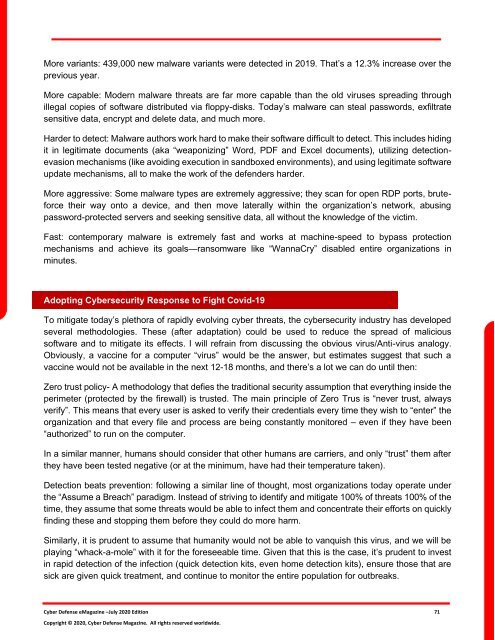Cyber Defense eMagazine July 2020 Edition
Cyber Defense eMagazine July Edition for 2020 #CDM #CYBERDEFENSEMAG @CyberDefenseMag by @Miliefsky a world-renowned cyber security expert and the Publisher of Cyber Defense Magazine as part of the Cyber Defense Media Group as well as Yan Ross, US Editor-in-Chief, Pieruligi Paganini, Co-founder & International Editor-in-Chief, Stevin Miliefsky, President and many more writers, partners and supporters who make this an awesome publication! Thank you all and to our readers! OSINT ROCKS! #CDM #CDMG #OSINT #CYBERSECURITY #INFOSEC #BEST #PRACTICES #TIPS #TECHNIQUES
Cyber Defense eMagazine July Edition for 2020 #CDM #CYBERDEFENSEMAG @CyberDefenseMag by @Miliefsky a world-renowned cyber security expert and the Publisher of Cyber Defense Magazine as part of the Cyber Defense Media Group as well as Yan Ross, US Editor-in-Chief, Pieruligi Paganini, Co-founder & International Editor-in-Chief, Stevin Miliefsky, President and many more writers, partners and supporters who make this an awesome publication! Thank you all and to our readers! OSINT ROCKS! #CDM #CDMG #OSINT #CYBERSECURITY #INFOSEC #BEST #PRACTICES #TIPS #TECHNIQUES
You also want an ePaper? Increase the reach of your titles
YUMPU automatically turns print PDFs into web optimized ePapers that Google loves.
More variants: 439,000 new malware variants were detected in 2019. That’s a 12.3% increase over the<br />
previous year.<br />
More capable: Modern malware threats are far more capable than the old viruses spreading through<br />
illegal copies of software distributed via floppy-disks. Today’s malware can steal passwords, exfiltrate<br />
sensitive data, encrypt and delete data, and much more.<br />
Harder to detect: Malware authors work hard to make their software difficult to detect. This includes hiding<br />
it in legitimate documents (aka “weaponizing” Word, PDF and Excel documents), utilizing detectionevasion<br />
mechanisms (like avoiding execution in sandboxed environments), and using legitimate software<br />
update mechanisms, all to make the work of the defenders harder.<br />
More aggressive: Some malware types are extremely aggressive; they scan for open RDP ports, bruteforce<br />
their way onto a device, and then move laterally within the organization’s network, abusing<br />
password-protected servers and seeking sensitive data, all without the knowledge of the victim.<br />
Fast: contemporary malware is extremely fast and works at machine-speed to bypass protection<br />
mechanisms and achieve its goals—ransomware like “WannaCry” disabled entire organizations in<br />
minutes.<br />
Adopting <strong>Cyber</strong>security Response to Fight Covid-19<br />
To mitigate today’s plethora of rapidly evolving cyber threats, the cybersecurity industry has developed<br />
several methodologies. These (after adaptation) could be used to reduce the spread of malicious<br />
software and to mitigate its effects. I will refrain from discussing the obvious virus/Anti-virus analogy.<br />
Obviously, a vaccine for a computer “virus” would be the answer, but estimates suggest that such a<br />
vaccine would not be available in the next 12-18 months, and there’s a lot we can do until then:<br />
Zero trust policy- A methodology that defies the traditional security assumption that everything inside the<br />
perimeter (protected by the firewall) is trusted. The main principle of Zero Trus is “never trust, always<br />
verify”. This means that every user is asked to verify their credentials every time they wish to “enter” the<br />
organization and that every file and process are being constantly monitored – even if they have been<br />
“authorized” to run on the computer.<br />
In a similar manner, humans should consider that other humans are carriers, and only “trust” them after<br />
they have been tested negative (or at the minimum, have had their temperature taken).<br />
Detection beats prevention: following a similar line of thought, most organizations today operate under<br />
the “Assume a Breach” paradigm. Instead of striving to identify and mitigate 100% of threats 100% of the<br />
time, they assume that some threats would be able to infect them and concentrate their efforts on quickly<br />
finding these and stopping them before they could do more harm.<br />
Similarly, it is prudent to assume that humanity would not be able to vanquish this virus, and we will be<br />
playing “whack-a-mole” with it for the foreseeable time. Given that this is the case, it’s prudent to invest<br />
in rapid detection of the infection (quick detection kits, even home detection kits), ensure those that are<br />
sick are given quick treatment, and continue to monitor the entire population for outbreaks.<br />
<strong>Cyber</strong> <strong>Defense</strong> <strong>eMagazine</strong> –<strong>July</strong> <strong>2020</strong> <strong>Edition</strong> 71<br />
Copyright © <strong>2020</strong>, <strong>Cyber</strong> <strong>Defense</strong> Magazine. All rights reserved worldwide.


















